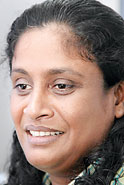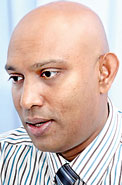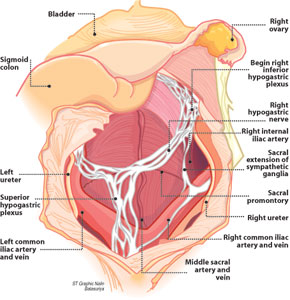When all fails, LPSN
With a first under his scalpel, Consultant Obstetrician and Gynaecologist, Dr. Dhammike Silva discusses laparoscopic pre-sacral neurectomy that has taken keyhole surgery to a new level in Sri Lanka while giving relief to a woman who had suffered intense lower abdominal pain for years.
For four long years, she suffered. The episodes came and went but were so excruciating that she would faint when they gripped her.
The house was in disarray. She was frightened to go out. Both her husband and daughter watched helplessly as R.P. Pushpagaya of Homagama struggled to face the terrifying agony.
 R.P. Pushpagaya |
 Dr. Dhammike Silva |
Sponge ekak thada karala, atha arinava wage, says Pushpagaya of those dreaded days when her yati bada (lower abdomen) would feel like a sponge that was squeezed very tightly and then released.
Nothing worked, even though she went to several doctors and tried many medications. She just had to swallow pain-killers, grit her teeth, press a pillow tightly against her stomach and bear the pain.
This was until she came to the Kalubowila Hospital’s clinic of Consultant Obstetrician and Gynaecologist, Dr. Dhammike Silva who has taken laparascopic surgery to a different level in Sri Lanka.
The minimally-invasive laparascopic surgical procedure also known as key-hole surgery that Dr. Silva and his team performed on Pushpagaya on April 29 is probably a first in the country, MediScene understands.
When Pushpagaya came to Dr. Silva, she was in a lot of pain and all the conventional medications had been tried out on her to no avail. She had taken the highest doses permissible, but with absolutely no pain relief, points out Dr. Silva, explaining that the decision to perform a laparoscopic pre-sacral neurectomy (LPSN) was not taken lightly.
“For this procedure, there has to be careful patient selection and it is carried out only when all other means have failed, as it is not without both intra-operational and long-term complications,” he says. LPSN is the removal of the pre-sacral plexus, the group of nerves that conducts the pain signal from the uterus to the brain, using three tiny incisions on the abdomen, MediScene learns.

It seems easy enough but the pre-sacral plexus is in an area of big blood vessels and organs and in fact the doctors would be working and navigating literally in a “minefield”. One small nick could easily spell disaster and death. The biggest blood vessel in the human body, the aorta is in this area, as well as very big veins, says Dr. Silva, explaining that the common iliac arteries and veins and also the ureters are here.
The procedure would involve getting into the area and cutting off the plexus of nerves or as Dr. Silva calls it, the “relay station” through which most pain fibres from the pelvis are channelled to the brain. “The relay station has to be removed.”
Detailing the procedure, this adept laparascopic doctor says that after Pushpagaya was anaesthetized or put to sleep, a thin needle pumped gas into her tummy or abdomen, causing it to expand. Three tiny cuts were then made, a one-cm incision inside her umbilicus (navel) and two 5-mm incisions on the left side of her tummy.
Providing an anatomy lesson to the uninitiated, Dr. Silva says that just below the peritoneal surface is a shiny membrane covering all the bones, organs, blood vessels and nerves which are closely-packed together with soft tissue. The telescope was inserted through the umbilicus “port” which brings 10-times magnified, “very clear” pictures of the inside of the abdomen to a screen which the team looks at to find their way around. The side incisions were the “operating ports” through which the surgical instruments, scissors, were inserted.
Thereafter, in this three-hour procedure, a cut on the surface packing exposed all the major structures, which if damaged would put the doctors and the patient in trouble. The nerves were then sifted and cut while any tiny blood vessels which got cut had to be sealed. If a major blood vessel like the aorta is nicked, “serious trouble” would follow as the patient could easily haemorrhage (bleed) to death, says Dr. Silva, adding that then a Vascular Surgeon would have to be called in. This would be one of the intra-operative complications. Pushpagaya came out of this procedure sans complications.
The long-term complications could be bladder and bowel dysfunction which includes difficulty in voiding or emptying and constipation. This is why LPSN, which is “a radical procedure” in which nerves — although they are sympathetic nerve fibres — are cut off, cannot be tried on every patient, says Dr. Silva.
Although there is no 100% cure for the kind of pain that Pushpagaya was suffering, a three-year follow-up study on those who have undergone this procedure abroad has found that there is 50-60% of pain reduction, MediScene learns. This is “very good” in cases like Pushpagaya’s as there is no other respite, says Dr. Silva, explaining that in contrast open-surgery would entail a lot more bleeding and longer recovery period.
Commending each and every member of his team for a job well done, he says that the support of Prof. Jayantha Jayawardena who holds the Obstetrics and Gynaecology Chair at the Sri Jayewardenepura Medical Faculty is immense. His team included Consultant Anaesthetist, Dr. Nilangani Lamahewage; Senior Registrars Dr. Probhodana Ranaweera and Dr. M. Ziard; Dr. Mihiri Fernando, Dr. Muditha, Dr. M. Tayabaran, Dr. S. Srisanjeevan and Dr. D.D. Dikowita; Theatre Sister N. Malawiarachchi; and Scrub Nurses H. Malawiarachchi, K.C.N. Kulasekara and K.P.M.S. de Silva.
Smiling Pushpagaya, now free of pain, indicates to MediScene that she and her family “ping denava” (give blessings) to the doctors daily when they offer flowers at the shrine of the Buddha they have at home. “I worshipped Dr. Silva before I went home,” she says, adding, he is a “mihipita deviyo” (a god on earth).
Follow @timesonlinelk
comments powered by Disqus


